
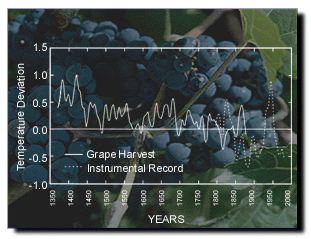 Historical
Data:
Historical
Data:
Historical documents contain a wealth of information about past climates. Observations of weather and climatic conditions can be found in ship and farmers' logs, travelers' diaries, newspaper accounts, and other written records. When properly evaluated, historical data can yield both qualitative and quantitative information about past climate. The example above demonstrates how historical grape harvest dates were used to reconstruct summer temperatures (April - September) in Paris from 1370 - 1879. [From Bradley, 1990; based on data from Le Roy Ladurie and Baulant, 1980.]
|
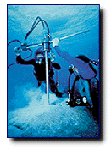 Corals:
Corals:
Corals build their hard skeletons from calcium carbonate, a mineral extracted from sea water. The carbonate contains isotopes of oxygen, as well as trace metals, that can be used to determine the temperature of the water in which the coral grew. These temperature recordings can then be used to reconstruct climate when the coral lived. To learn more about the study of corals please visit |
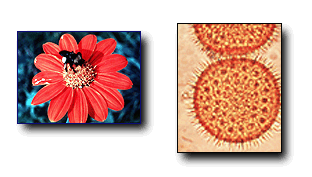 Fossil Pollen:
Fossil Pollen:
All flowering plants produce pollen grains. Their distinctive shapes can be used to identify the type of plant from which they came. Since pollen grains are well preserved in the sediment layers in the bottom of a pond, lake or ocean, an analysis of the pollen grains in each layer tell us what kinds of plants were growing at the time the sediment was deposited.�Inferences can then be made about the climate based on the types of plants found in each layer. To learn more about fossil pollen, please visit the following:
|
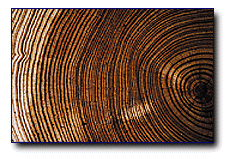 Tree Rings:
Tree Rings:
Since tree growth is influenced by climatic conditions, patterns in tree-ring widths, density, and isotopic composition reflect variations in climate.� In temperate regions where there is a distinct growing season, trees generally produce one ring a year, and thus record the climatic conditions of each year.�Trees can grow to be hundreds to thousands of years old and can contain annually-resolved records of climate for centuries to millennia. To learn more about tree rings please visit the following:
|
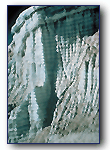 Ice Cores:
Ice Cores:
Located high in mountains and in polar ice caps, ice has accumulated from snowfall over many millenia. Scientists drill through the deep ice to collect ice cores. These cores contain dust, air bubbles, or isotopes of oxygen, that can be used to interpret the past climate of that area. To learn more about ice cores please visit the following sites:
|
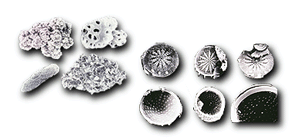 Ocean
& Lake Sediments: Ocean
& Lake Sediments:
Billions of tons of sediment accumulate in the ocean and lake basins each year. Scientist drill cores of sediment from the basin floors. Ocean and lake sediments include tiny fossils and chemicals that are used to interpret past climates. To learn more about ocean & lake sediments, please visit the following:
|